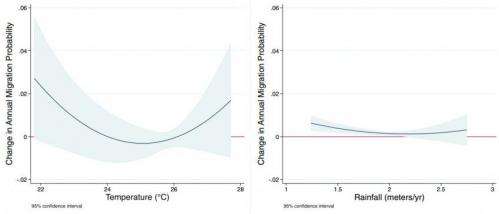Nonlinear effects of temperature and precipitation on annual migration probability. Credit: Pratikshya Bohra-Mishra, PNAS, doi: 10.1073/pnas.1317166111
(Phys.org) —A team of researchers in the U.S. has found that local temperature increases only caused permanent migration in Indonesia when such increases occurred above 25 °C, providing hints of possible migration patterns as global warming continues in the future. In their paper published in Proceedings of the National Academy of Sciences, the team describes how they used data from another study to track migration over a multi-year period as a means of predicting migration patterns due to global warming.
Indonesia is the fourth most populous country in the world with its people scattered over many islands. It's also a place with frequent earthquakes and volcanic eruptions—approximately 40 percent of the people in that country make their living from agriculture, generally near the coasts. Taken together, these factors will likely mean major disruptions for the country as global warming causes temperatures to rise, rainfall to change and sea levels to rise. In their study, the researchers sought to learn how temperature and rainfall changes impacted permanent migration in the country, from one region or island to another.
The researchers used data from the Rand Corporation's, The Indonesia Family Life Survey, which has been running since 1993/94. Among other things, the survey tracks the movement of 7,185 people living in that country. The researchers compared the migratory data from the survey with weather data from the same period to see if any patterns might emerge. They found that if the average temperature for any given place was below, 25 °C, small increases in temperature did not give rise to permanent migrations. In places where the average temperature was above 25 °C, however, temperature increases did cause permanent migration to occur. And the more temperature increased, the more people moved away. As an example, they noted that a one degree rise, from 26 to 27 degrees raised the probability of migration by 0.8 percent, but the probability jumped to 1.4 percent if the temperature rose from 27 to 28 degrees. They noted that changes in rainfall had a similar impact, but was not as pronounced.
The team conducted similar studies on natural disasters in the area to see if they had a similar impact and found migration from such events tended to be short term as people generally moved back when able to do so.
The researchers suggest their results indicate that Indonesia is likely to see large permanent migration as global warming causes rising temperatures, with people moving away from some of the most heavily populated provinces, such as Jakarta. They note also that such migration trends are likely to occur in other countries as well.
More information: Nonlinear permanent migration response to climatic variations but minimal response to disasters, Pratikshya Bohra-Mishra, PNAS, DOI: 10.1073/pnas.1317166111
Abstract
We present a microlevel study to simultaneously investigate the effects of variations in temperature and precipitation along with sudden natural disasters to infer their relative influence on migration that is likely permanent. The study is made possible by the availability of household panel data from Indonesia with an exceptional tracking rate combined with frequent occurrence of natural disasters and significant climatic variations, thus providing a quasi-experiment to examine the influence of environment on migration. Using data on 7,185 households followed over 15 y, we analyze whole-household, province-to-province migration, which allows us to understand the effects of environmental factors on permanent moves that may differ from temporary migration. The results suggest that permanent migration is influenced by climatic variations, whereas episodic disasters tend to have much smaller or no impact on such migration. In particular, temperature has a nonlinear effect on migration such that above 25 °C, a rise in temperature is related to an increase in outmigration, potentially through its impact on economic conditions. We use these results to estimate the impact of projected temperature increases on future permanent migration. Though precipitation also has a similar nonlinear effect on migration, the effect is smaller than that of temperature, underscoring the importance of using an expanded set of climatic factors as predictors of migration. These findings on the minimal influence of natural disasters and precipitation on permanent moves supplement previous findings on the significant role of these variables in promoting temporary migration.
Journal information: Proceedings of the National Academy of Sciences
© 2014 Phys.org























